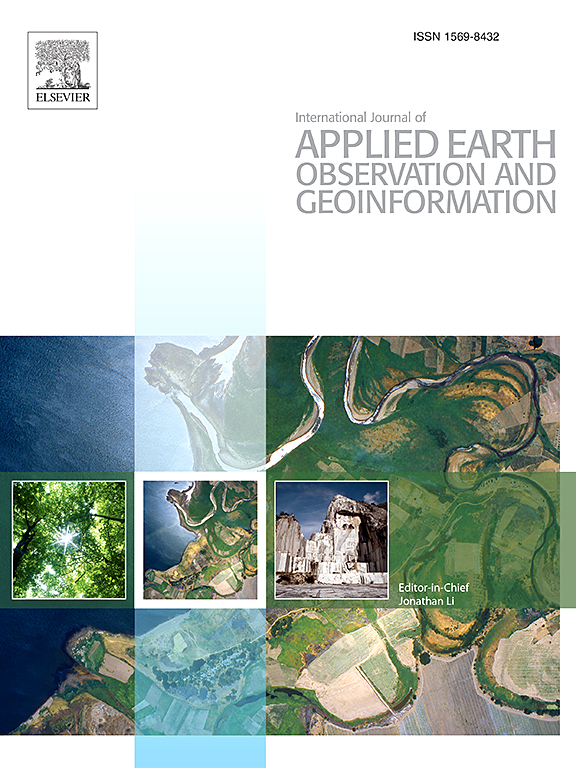A novel topographic correction framework for detecting forest disturbance from annual wide-time-window Landsat time series
IF 7.6
Q1 REMOTE SENSING
International journal of applied earth observation and geoinformation : ITC journal
Pub Date : 2025-05-01
DOI:10.1016/j.jag.2025.104568
引用次数: 0
Abstract
Topographic effects in mountainous forested regions disrupt the spectral consistency of remote sensing imagery, hindering accurate forest disturbance detection in Landsat time series acquired over wide time intervals (WTW-LTSs). This study evaluates the necessity of topographic correction for improving forest disturbance detection and proposes a novel post-processing topographic correction framework using the sun-canopy-sensor with C corrections (SCS + C) model. The framework simulates spectral reflectance distortions from illumination variations in uncorrected WTW-LTSs before change detection and employs post-processing to remove the resulting topographic artifacts from detected disturbances. Applied in Yunnan Province, China, the results show that (1) the post-processing framework effectively distinguishes topographic artifacts caused by intra-annual variations, achieving a high accuracy of 81.65 %; (2) by removing topographic artifacts, the post-processing framework significantly enhances forest disturbance detection, improving overall accuracy (OA), user’s accuracy (UA), and producer’s accuracy (PA) by 0.38 %–0.51 %, 1.08 %–1.83 %, and 0.18 %–2.18 %, respectively; (3) the pre-processing framework introduces uncertainties, reducing OA and PA by 0.1 % and 1.93 %–2.99 %, leading to the omission of 14.15 %–16.77 % of disturbances and the false detection of 10.03 %–14.57 % of new disturbances. These findings underscore the importance of eliminating topographic effects in WTW-LTSs for accurate forest disturbance detection. The proposed post-processing framework significantly improves accuracy, particularly in complex terrains, contributing to more reliable disturbance maps. This advancement provides valuable insights for ecological monitoring and supports sustainable forest management for mountainous regions.
基于年宽时窗Landsat时间序列的森林扰动探测地形校正框架
山地森林地区的地形效应破坏了遥感图像的光谱一致性,阻碍了在大时间间隔(WTW-LTSs)获取的Landsat时间序列中准确检测森林扰动。本研究评估了地形校正对改善森林扰动检测的必要性,并提出了一种基于C校正(SCS + C)模型的新型后处理地形校正框架。该框架在变化检测之前模拟未校正wtw - lts中光照变化造成的光谱反射失真,并采用后处理从检测到的干扰中去除所产生的地形伪影。结果表明:(1)该后处理框架能有效识别年际变化引起的地形伪影,精度达到81.65%;(2)通过去除地形伪影,后处理框架显著增强了森林干扰检测,整体精度(OA)、用户精度(UA)和生产者精度(PA)分别提高了0.38% ~ 0.51%、1.08% ~ 1.83%和0.18% ~ 2.18%;(3)预处理框架引入了不确定性,使OA和PA分别降低了0.1%和1.93% ~ 2.99%,导致14.15% ~ 16.77%的干扰被遗漏,10.03% ~ 14.57%的新干扰被误检。这些发现强调了在WTW-LTSs中消除地形影响对于准确检测森林干扰的重要性。提出的后处理框架显著提高了精度,特别是在复杂地形中,有助于获得更可靠的扰动图。这一进展为生态监测提供了有价值的见解,并支持山区森林的可持续管理。
本文章由计算机程序翻译,如有差异,请以英文原文为准。
求助全文
约1分钟内获得全文
求助全文
来源期刊

International journal of applied earth observation and geoinformation : ITC journal
Global and Planetary Change, Management, Monitoring, Policy and Law, Earth-Surface Processes, Computers in Earth Sciences
CiteScore
12.00
自引率
0.00%
发文量
0
审稿时长
77 days
期刊介绍:
The International Journal of Applied Earth Observation and Geoinformation publishes original papers that utilize earth observation data for natural resource and environmental inventory and management. These data primarily originate from remote sensing platforms, including satellites and aircraft, supplemented by surface and subsurface measurements. Addressing natural resources such as forests, agricultural land, soils, and water, as well as environmental concerns like biodiversity, land degradation, and hazards, the journal explores conceptual and data-driven approaches. It covers geoinformation themes like capturing, databasing, visualization, interpretation, data quality, and spatial uncertainty.
 求助内容:
求助内容: 应助结果提醒方式:
应助结果提醒方式:


